Synergistic Effect of Yak Dung Fiber and Yak Dung Ash on the Mechanical and Shrinkage Properties of Cement Mortar
Abstract
1. Introduction
2. Experimental Section
2.1. Materials
2.2. Treatment of Yak Dung
2.2.1. Preparation of YDF
2.2.2. Preparation of YDA
2.3. Mix Proportions and Specimen Preparation
2.4. Characterization and Test
2.4.1. Physical and Mechanical Properties
2.4.2. Shrinkage Test
2.4.3. Microstructure Analysis
3. Results and Discussion
3.1. Surface Morphology Characterization of YDF
3.2. Characterization of the Surface Morphology and Elemental Composition of YDA
3.3. Fluidity
3.4. Compressive Strength
3.5. Flexural Strength
3.6. Shrinkage Test
3.7. Statistical Analysis Based on ANOVA
3.8. Scanning Electron Microscope Analysis
4. Conclusions
Author Contributions
Funding
Institutional Review Board Statement
Informed Consent Statement
Data Availability Statement
Acknowledgments
Conflicts of Interest
References
- Zhang, Y.; Shen, L.; Shuai, C.; Tan, Y.; Ren, Y.; Wu, Y. Is the low-carbon economy efficient in terms of sustainable development? A global perspective. Sustain. Dev. 2019, 27, 130–152. [Google Scholar] [CrossRef]
- Shen, M.; Huang, W.; Chen, M.; Song, B.; Zeng, G.; Zhang, Y. (Micro) plastic crisis: Un-ignorable contribution to global greenhouse gas emissions and climate change. J. Clean. Prod. 2020, 254, 120138. [Google Scholar] [CrossRef]
- Solaymani, S. CO2 emissions patterns in 7 top carbon emitter economies: The case of transport sector. Energy 2019, 168, 989–1001. [Google Scholar] [CrossRef]
- Xu, H.; Cao, S.; Xu, X. The development of highway infrastructure and CO2 emissions: The mediating role of agglomeration. J. Clean. Prod. 2022, 337, 130501. [Google Scholar] [CrossRef]
- Miller, S.A.; John, V.M.; Pacca, S.A.; Horvath, A. Carbon dioxide reduction potential in the global cement industry by 2050. Cement Concrete Res. 2018, 114, 115–124. [Google Scholar] [CrossRef]
- He, Z.; Zhu, X.; Wang, J.; Mu, M.; Wang, Y. Comparison of CO2 emissions from OPC and recycled cement production. Constr. Build. Mater. 2019, 211, 965–973. [Google Scholar] [CrossRef]
- Zhang, J.X.; Su, C.; Wang, C.; Jing, P.; Hou, Y. Review of energy-saving and emission-reduction issues and technologies in the construction of road infrastructure. J. Beijing Univ. Technol. 2022, 48, 243–260. [Google Scholar]
- Jiang, X.; Xiao, R.; Ma, Y.; Zhang, M.; Bai, Y.; Huang, B. Influence of waste glass powder on the physico-mechanical properties and microstructures of fly ash-based geopolymer paste after exposure to high temperatures. Constr. Build. Mater. 2020, 262, 120579. [Google Scholar] [CrossRef]
- Aprianti, E.; Shafigh, P.; Bahri, S.; Farahani, J.N. Supplementary cementitious materials origin from agricultural wastes-A review. Constr. Build. Mater. 2015, 74, 176–187. [Google Scholar] [CrossRef]
- Vishwakarma, V.; Ramachandran, D. Green Concrete mix using solid waste and nanoparticles as alternatives-A review. Constr. Build. Mater. 2018, 162, 96–103. [Google Scholar] [CrossRef]
- Wang, Y.; Shao, Y.; Matovic, M.D.; Whalen, J.K. Recycling combustion ash for sustainable cement production: A critical review with data-mining and time-series predictive models. Constr. Build. Mater. 2016, 123, 673–689. [Google Scholar] [CrossRef]
- Liu, B.; Meng, H.; Pan, G.; Zhou, H.; Li, D. Relationship between the fineness and specific surface area of iron tailing powder and its effect on compressive strength and drying shrinkage of cement composites. Constr. Build. Mater. 2022, 357, 129421. [Google Scholar] [CrossRef]
- Hisseine, O.A.; Soliman, N.A.; Tolnai, B.; Tagnit-Hamou, A. Nano-engineered ultra-high performance concrete for controlled autogenous shrinkage using nanocellulose. Cement Concrete Res. 2020, 137, 106217. [Google Scholar] [CrossRef]
- Guo, A.; Sun, Z.; Satyavolu, J. Impact of modified kenaf fibers on shrinkage and cracking of cement pastes. Constr. Build. Mater. 2020, 264, 120230. [Google Scholar] [CrossRef]
- Sha, A.; Ma, B.; Wang, H.; Hu, L.; Mao, X.; Zhi, X.; Chen, H.; Liu, Y.; Ma, F.; Liu, Z.; et al. Highway constructions on the Qinghai-Tibet Plateau: Challenge, research and practice. J. Road Eng. 2022, 2, 1–60. [Google Scholar] [CrossRef]
- Li, Y.; Li, X.; Liu, Y.; Nie, C.; Chen, C.; Niu, J.; Zhang, W. Comparison of Bacterial and Fungal Community Structure and Potential Function Analysis of Yak Feces before and after Weaning. Bio. Med. Res. Int. 2022, 2022, 1–17. [Google Scholar] [CrossRef]
- Xu, Z.; Cheng, S.; Zhen, L.; Pan, Y.; Zhang, X.; Wu, J.; Zou, X.; Bijaya, G.C.D. Impacts of Dung Combustion on the Carbon Cycle of Alpine Grassland of the North Tibetan Plateau. Environ. Manag. 2013, 52, 441–449. [Google Scholar] [CrossRef]
- Yalley, P.P.K.; Manu, D. Strength and durability properties of cow dung stabilised earth brick. Civ. Env. Res. 2013, 3, 117–125. [Google Scholar]
- Ma, Y.; Wu, S.; Zhuang, J.; Tong, J.; Qi, H. Tribological and physio-mechanical characterization of cow dung fibers reinforced friction composites: An effective utilization of cow dung waste. Tribol. Int. 2018, 131, 200–211. [Google Scholar] [CrossRef]
- Ojedokun, A.T.; Bello, O.S. Sequestering heavy metals from wastewater using cow dung. Water Resour. Ind. 2016, 13, 7–13. [Google Scholar] [CrossRef]
- Awasthi, M.K.; Duan, Y.; Awasthi, S.K.; Liu, T.; Zhang, Z. Effect of biochar and bacterial inoculum additions on cow dung composting. Bioresource Technol. 2020, 297, 122407. [Google Scholar] [CrossRef] [PubMed]
- Zhou, S.; Zhang, Y.; Dong, Y. Pretreatment for biogas production by anaerobic fermentation of mixed corn stover and cow dung. Energy 2012, 46, 644–648. [Google Scholar] [CrossRef]
- Ramalingam, R.J.; Sivachidambaram, M.; Vijaya, J.J.; Al-Lohedan, H.A.; Muthumareeswaran, M.R. Synthesis of porous activated carbon powder formation from fruit peel and cow dung waste for modified electrode fabrication and application. Biomass Bioenerg. 2020, 142, 105800. [Google Scholar] [CrossRef]
- Yadav, A.K.; Gaurav, K.; Kishor, R.; Suman, S.K. Stabilization of alluvial soil for subgrade using rice husk ash, sugarcane bagasse ash and cow dung ash for rural roads. Int. J. Pavement Res. Tech. 2017, 10, 254–261. [Google Scholar] [CrossRef]
- Rayaprolu, V.; Raju, P.P. Incorporation of cow dung ash to mortar and concrete. Int. J. Eng. Res. Appl. 2012, 2, 580–585. [Google Scholar]
- Li, K.; Yang, Z.; Zhang, Y.; Li, Y.; Lu, L.; Niu, D. Effect of pretreated cow dung fiber on mechanical and shrinkage properties of cementitious composites. J. Clean. Prod. 2022, 348, 131374. [Google Scholar] [CrossRef]
- Chaturvedi, S.; Vedrtnam, A.; Kumar, S.; Gunwant, D. Fabrication and characterization of a novel cow dung-polymer composite packaging film. Invertis J. Sci. Technol. 2020, 13, 79–87. [Google Scholar] [CrossRef]
- Fasake, V.; Dashora, K. A sustainable potential source of ruminant animal waste material (dung fiber) for various industrial applications: A review. Bioresour. Technol. Rep. 2021, 15, 100693. [Google Scholar] [CrossRef]
- Sahin, S.; Kocaman, B.; Orung, I.; Memis, S. Replacing cattle manure ash as cement into concrete. J. Appl. Sci. 2006, 6, 2840–2842. [Google Scholar] [CrossRef]
- Ojedokun, O.Y.; Adeniran, A.A.; Raheem, S.B.; Aderinto, S.J. Cow Dung Ash (CDA) as Partial Replacement of Cementing Material in the Production of Concrete. Br. J. Appl. Sci. Technol. 2014, 4, 3445–3454. [Google Scholar] [CrossRef]
- Mbereyaho, L.; Irafasha, D.; Habumugisha, E.; Musabirema, J. Assessment of Cohesive Soil—Cow Dung Mortar Properties as Replacement of Cement Mortar for Simple Plastering Works. Rwanda J. Eng. Sci. Technol. Environ. 2020, 3, 88–100. [Google Scholar] [CrossRef]
- Ramachandran, D.; Vishwakarma, V.; Viswanathan, K. Detailed studies of cow dung ash modified concrete exposed in fresh water. J. Build. Eng. 2018, 20, 173–178. [Google Scholar]
- Vedrtnam, A.; Gunwant, D. Improving fatigue behavior of cow-dung fiber reinforced epoxy composite using waste glass powder. Mater. Res. Express 2019, 6, 105408. [Google Scholar] [CrossRef]
- JTG 3420-2020; Testing Method for Cement and Cement Concrete for Highway Engineering. SAC: Beijing, China, 2020.
- GB 50119-2016; Code for Utility Technical of Concrete Admixtures. SAC: Beijing, China, 2016.
- Cao, F.; Qiao, H.; Li, Y.; Shu, X.; Cui, L. Effect of highland barley straw ash admixture on properties and microstructure of concrete. Constr. Build. Mater. 2021, 315, 125802. [Google Scholar] [CrossRef]
- GB/T 2419-2005; Test Method for Fluidity of Cement Mortar. SAC: Beijing, China, 2005.
- Fiore, V.; Di Bella, G.; Valenza, A. The effect of alkaline treatment on mechanical properties of kenaf fibers and their epoxy composites. Compos. Part B: Eng. 2015, 68, 14–21. [Google Scholar] [CrossRef]
- Zhang, Q.; Luan, C.; Yu, C.; Huang, Y.; Zhou, Z. Mechanisms of carbon black in multifunctional cement matrix: Hydration and microstructure perspectives. Constr. Build. Mater. 2022, 346, 128455. [Google Scholar] [CrossRef]
- Lertwattanaruk, P.; Suntijitto, A. Properties of natural fiber cement materials containing coconut coir and oil palm fibers for residential building applications. Constr. Build. Mater. 2015, 94, 664–669. [Google Scholar] [CrossRef]
- Xie, X.; Gou, G.; Wei, X.; Zhou, Z.; Jiang, M.; Xu, X.; Wang, Z.; Hui, D. Influence of pretreatment of rice straw on hydration of straw fiber filled cement based composites. Constr. Build. Mater. 2016, 113, 449–455. [Google Scholar] [CrossRef]
- Magudeaswaran, P.; AS, H. Development of Eco Brick and Concrete with the partial replacement of cow dung. Development 2018, 6, 2249–2254. [Google Scholar]
- Bazant, Z.P.; Murphy, W.P. Creep and shrinkage prediction model for analysis and design of concrete structures-model. BMatériaux et constructions 1995, 28, 357–365. [Google Scholar]
- Wu, L.; Farzadnia, N.; Shi, C.; Zhang, Z.; Wang, H. Autogenous shrinkage of high performance concrete: A review. Constr. Build. Mater. 2017, 149, 62–75. [Google Scholar] [CrossRef]
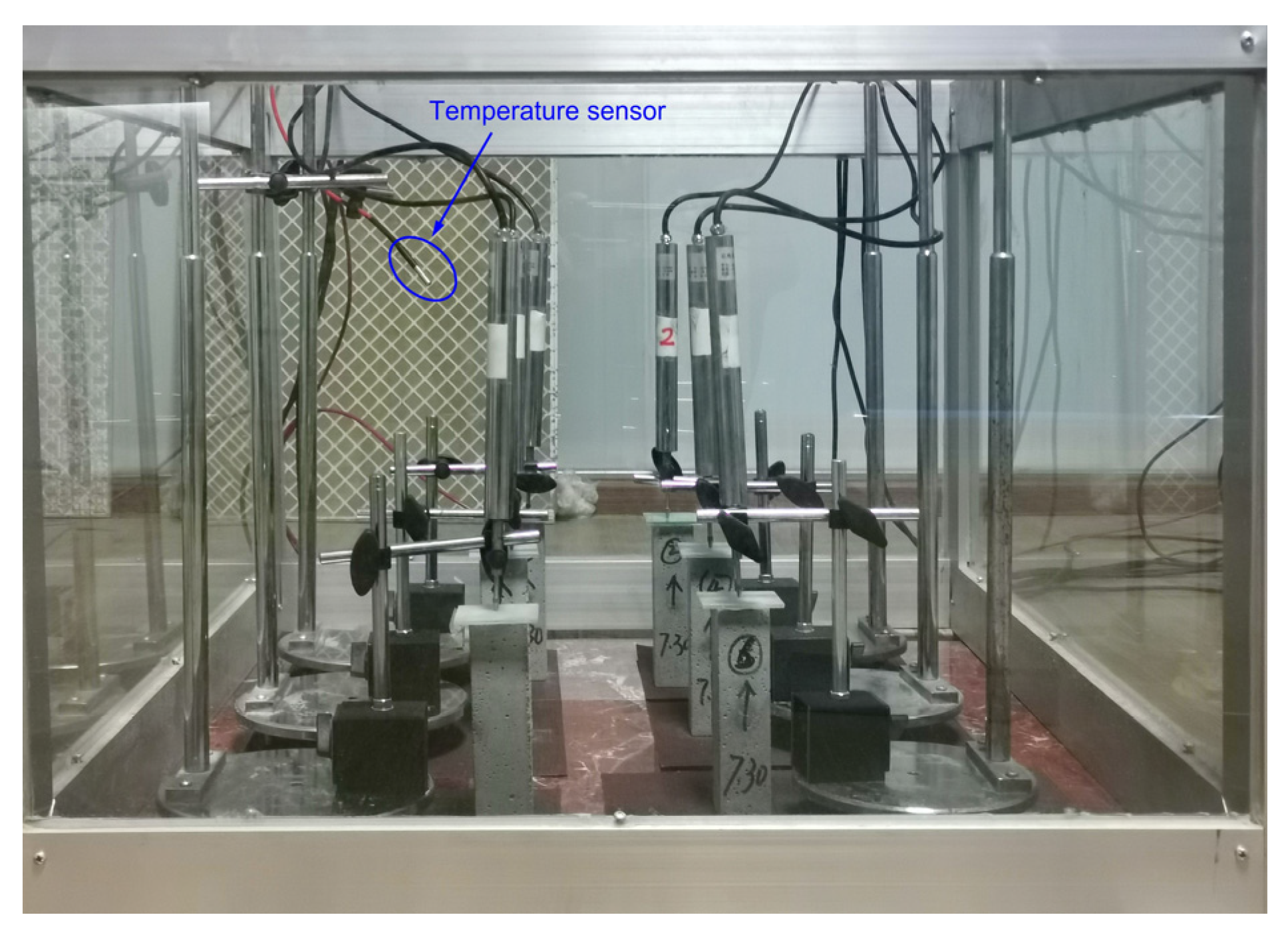
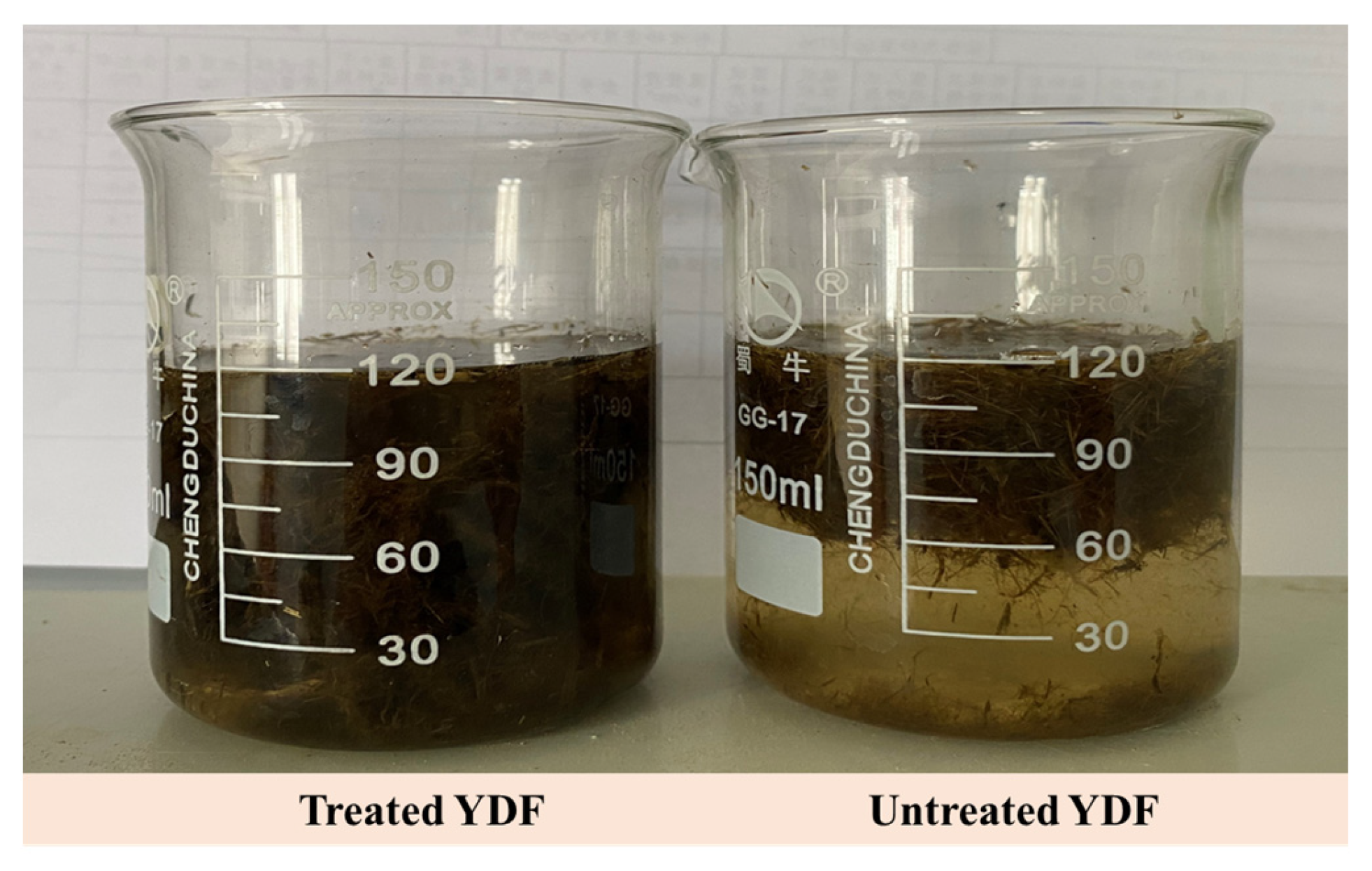
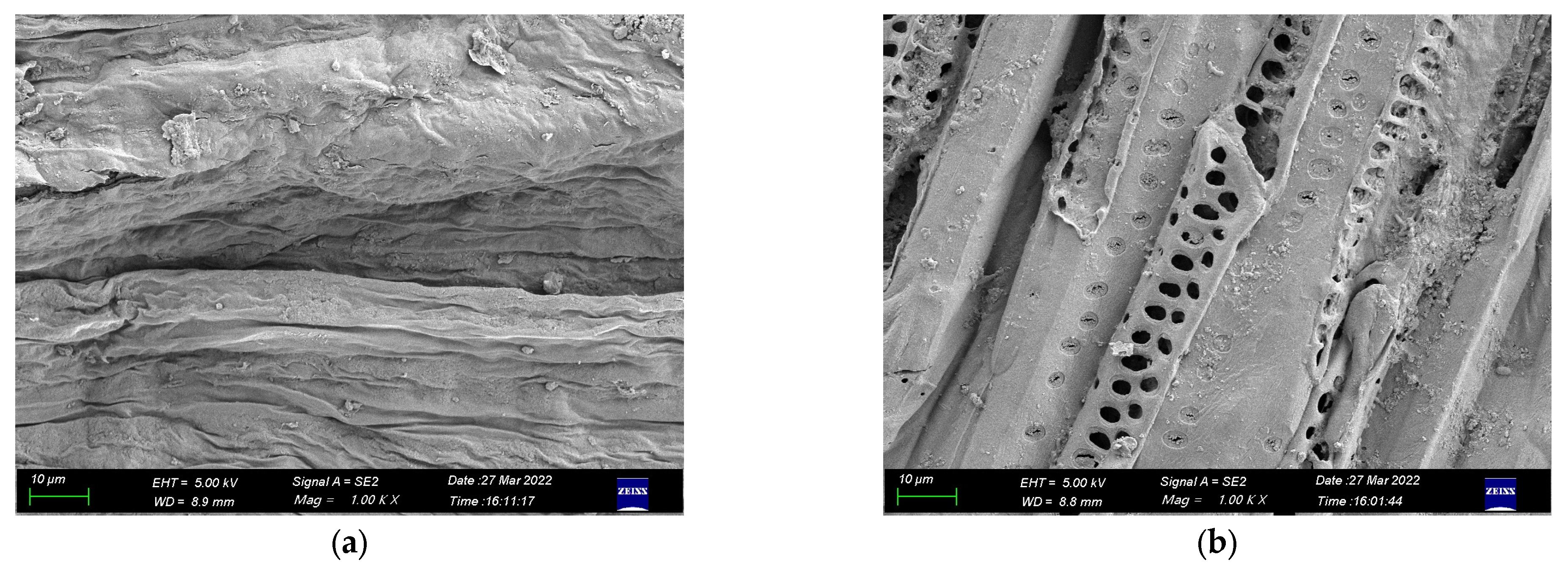
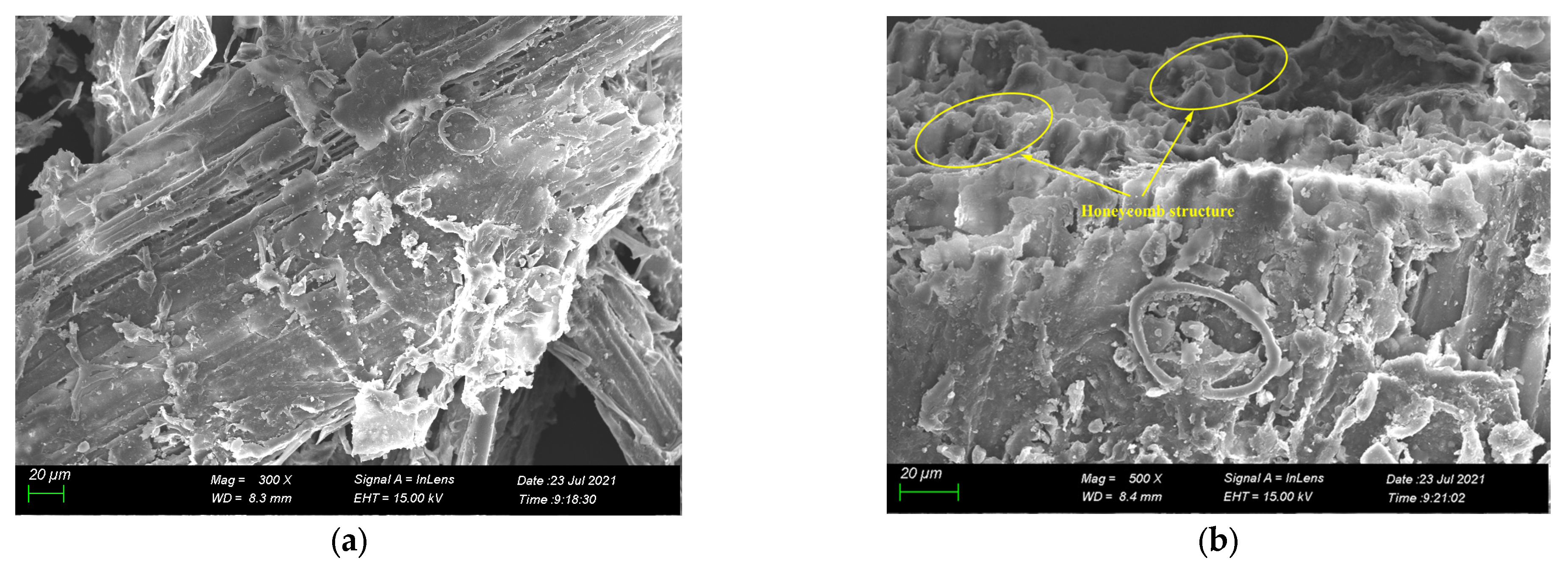
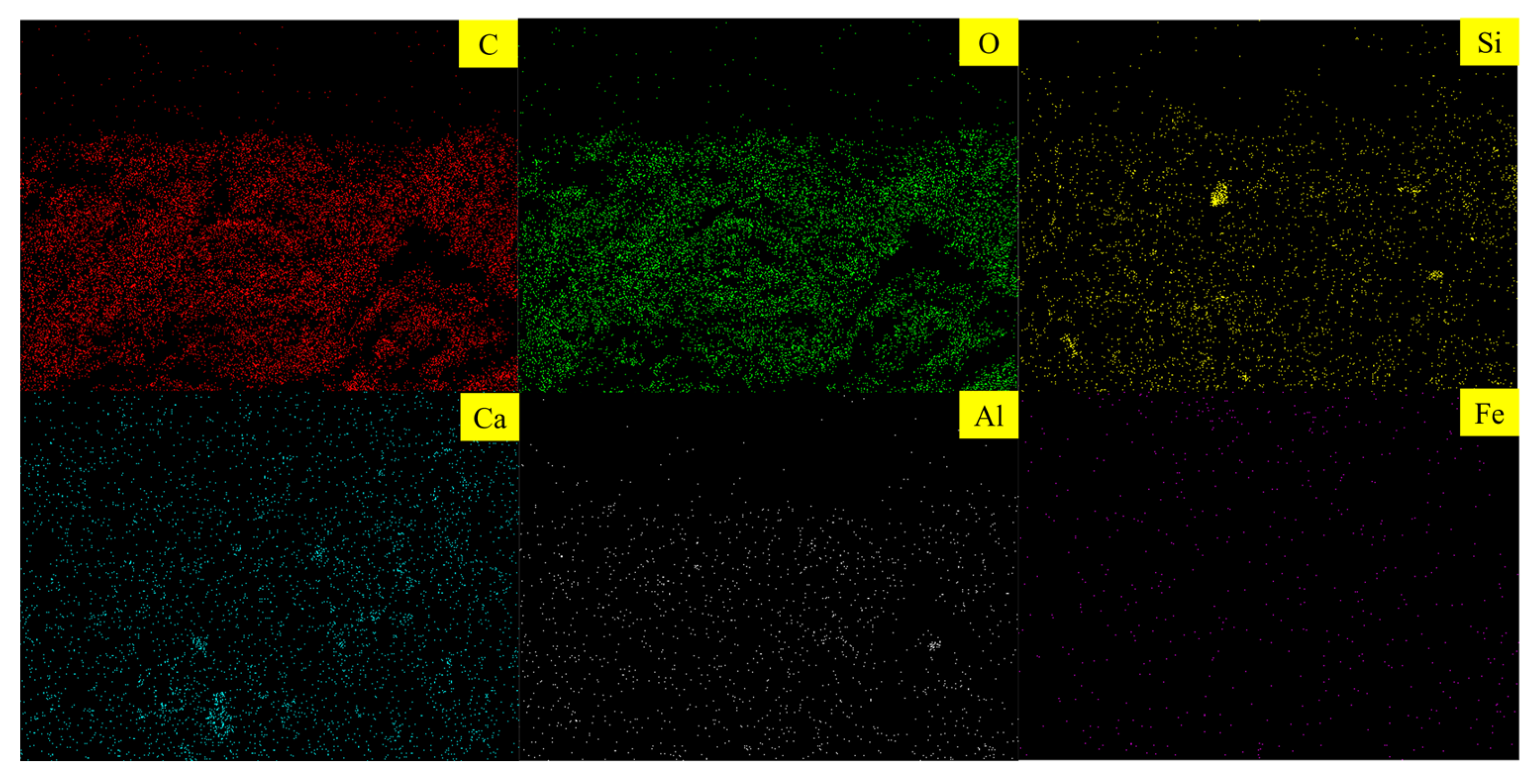
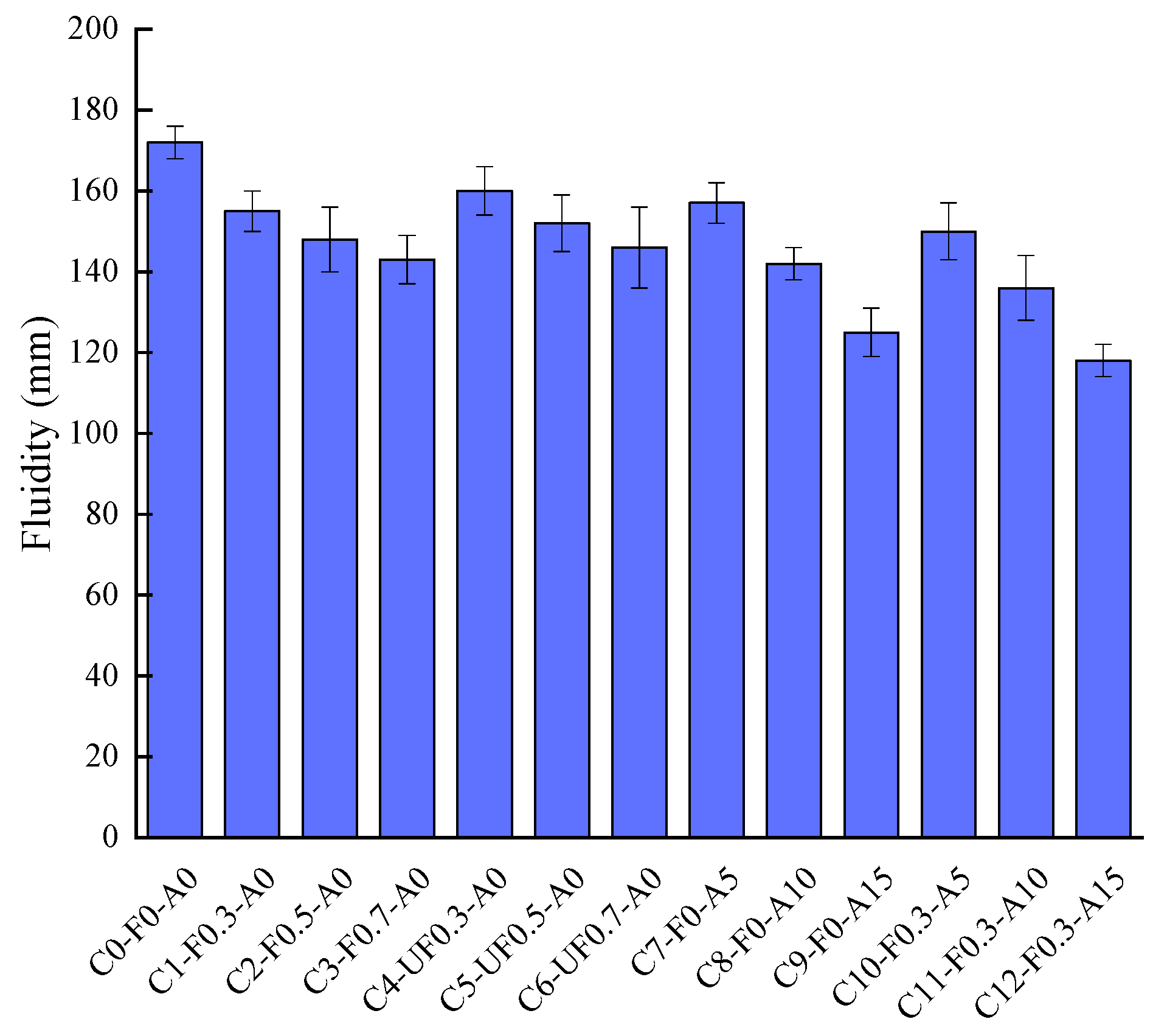
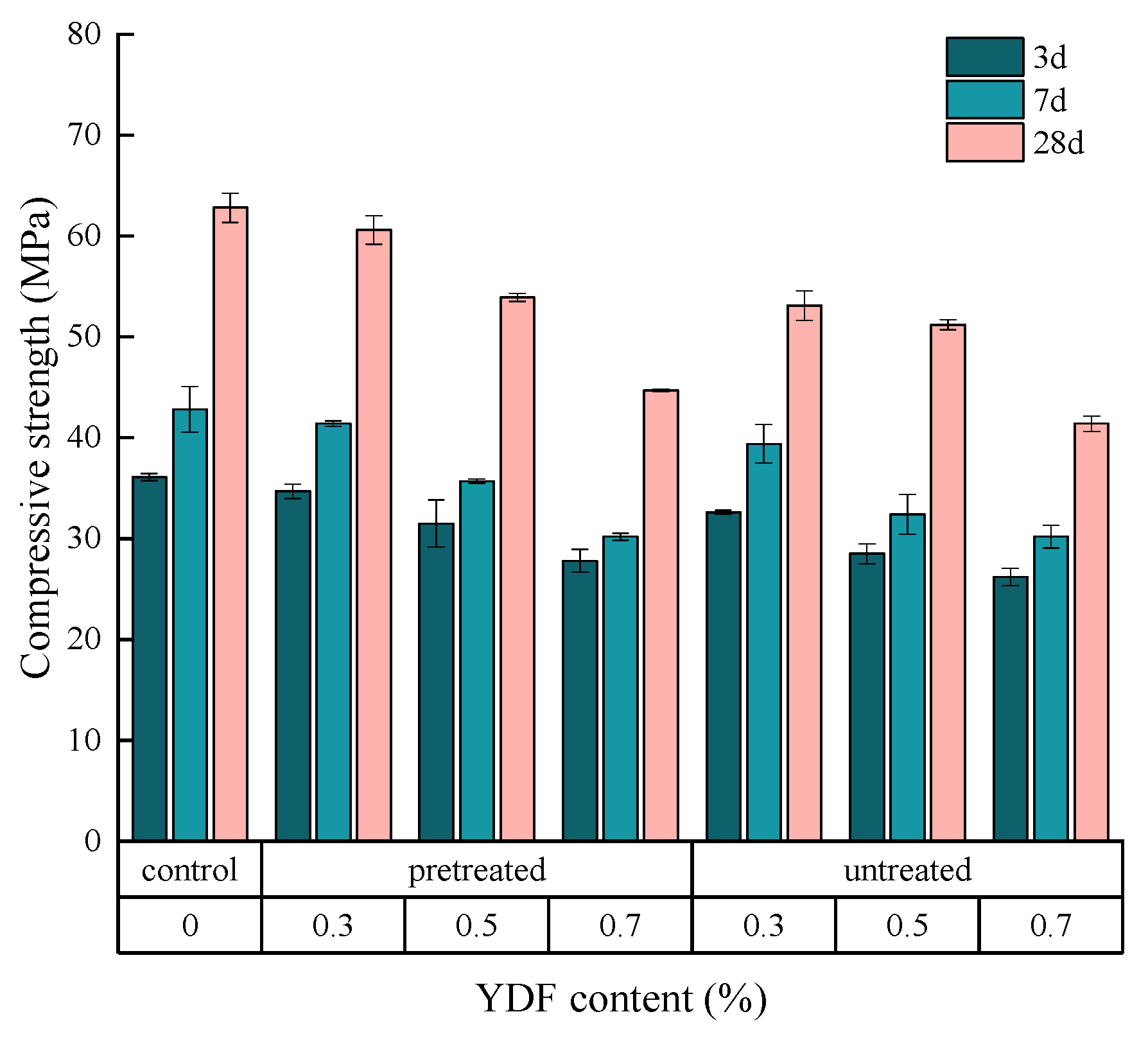
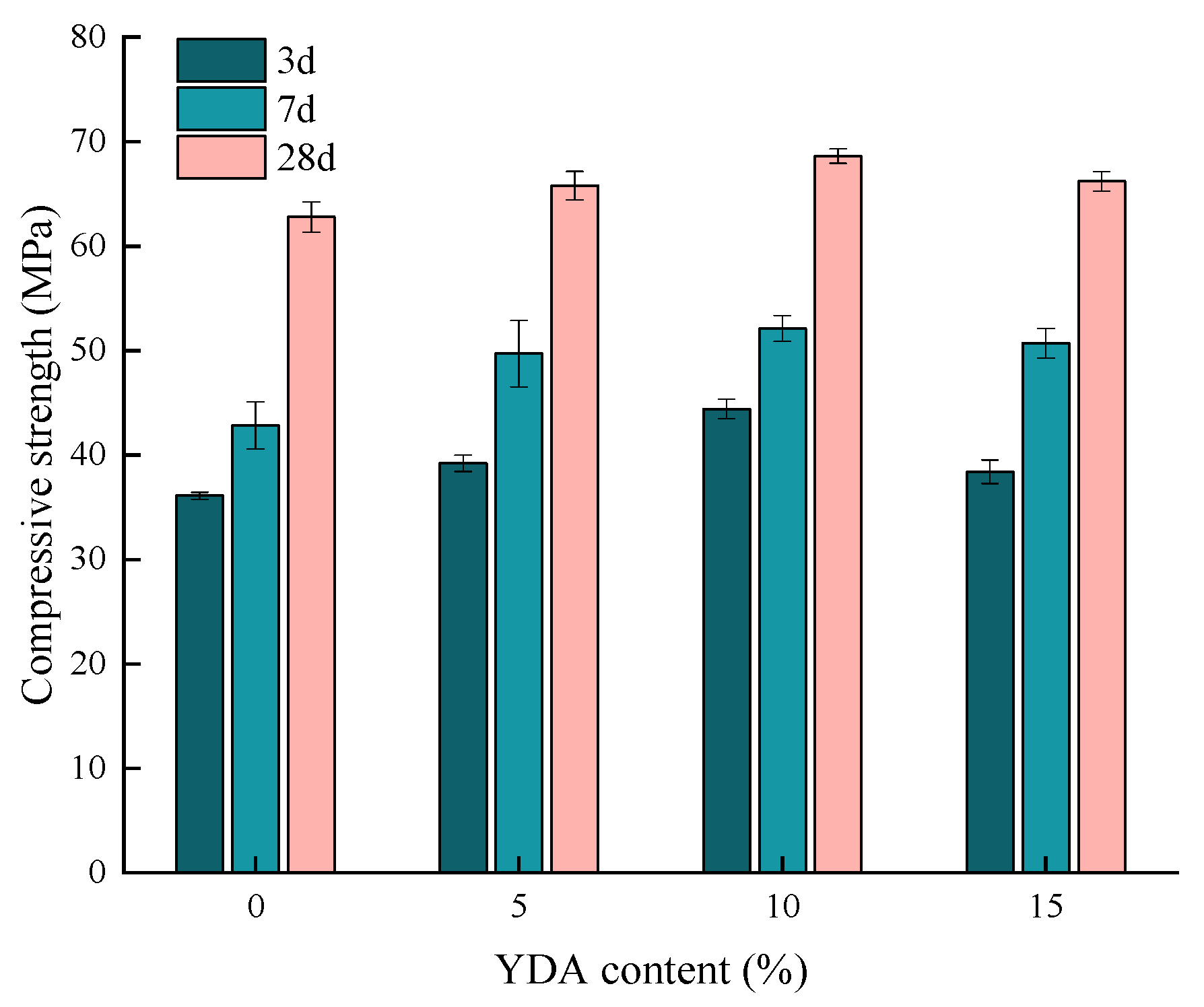



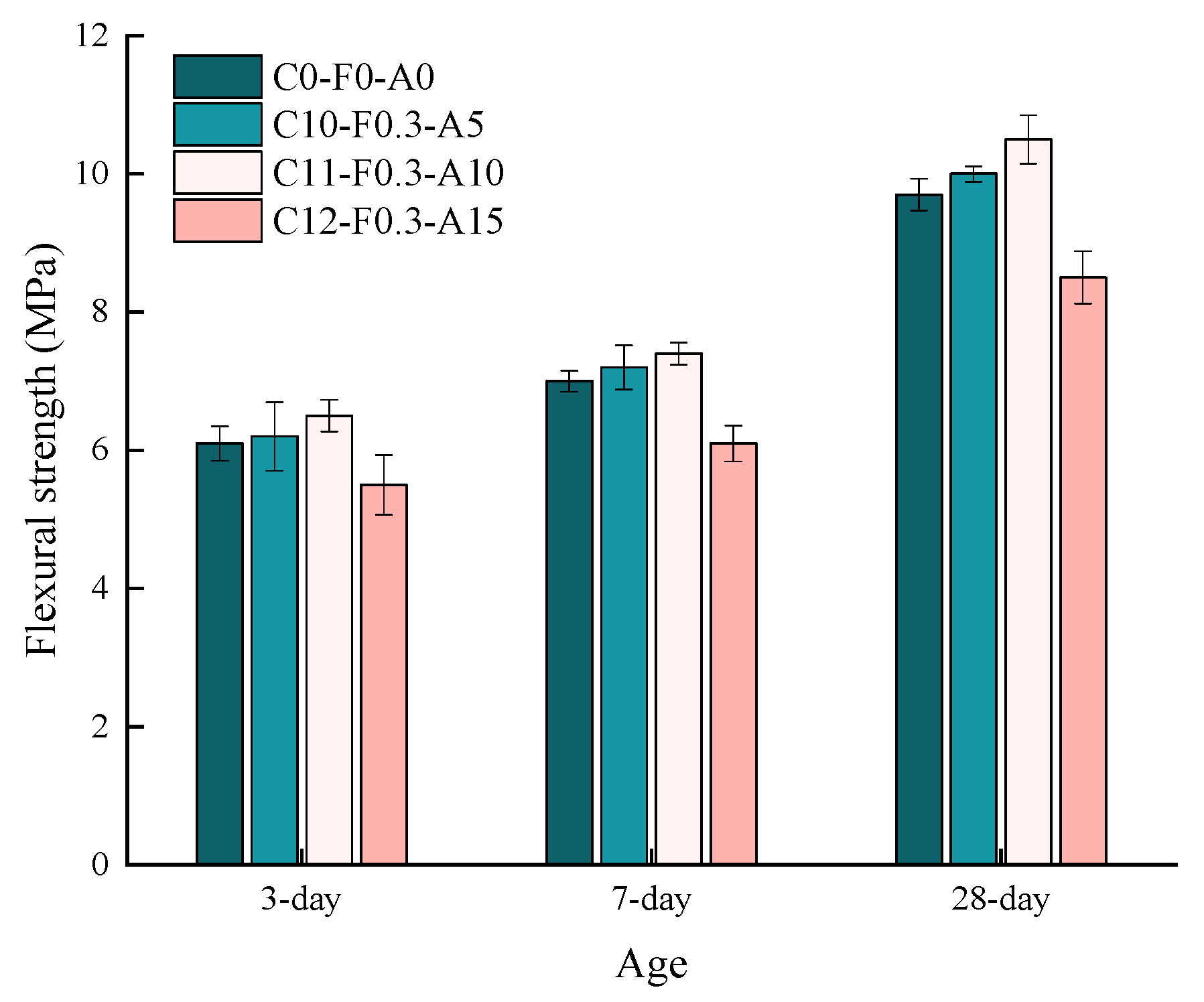
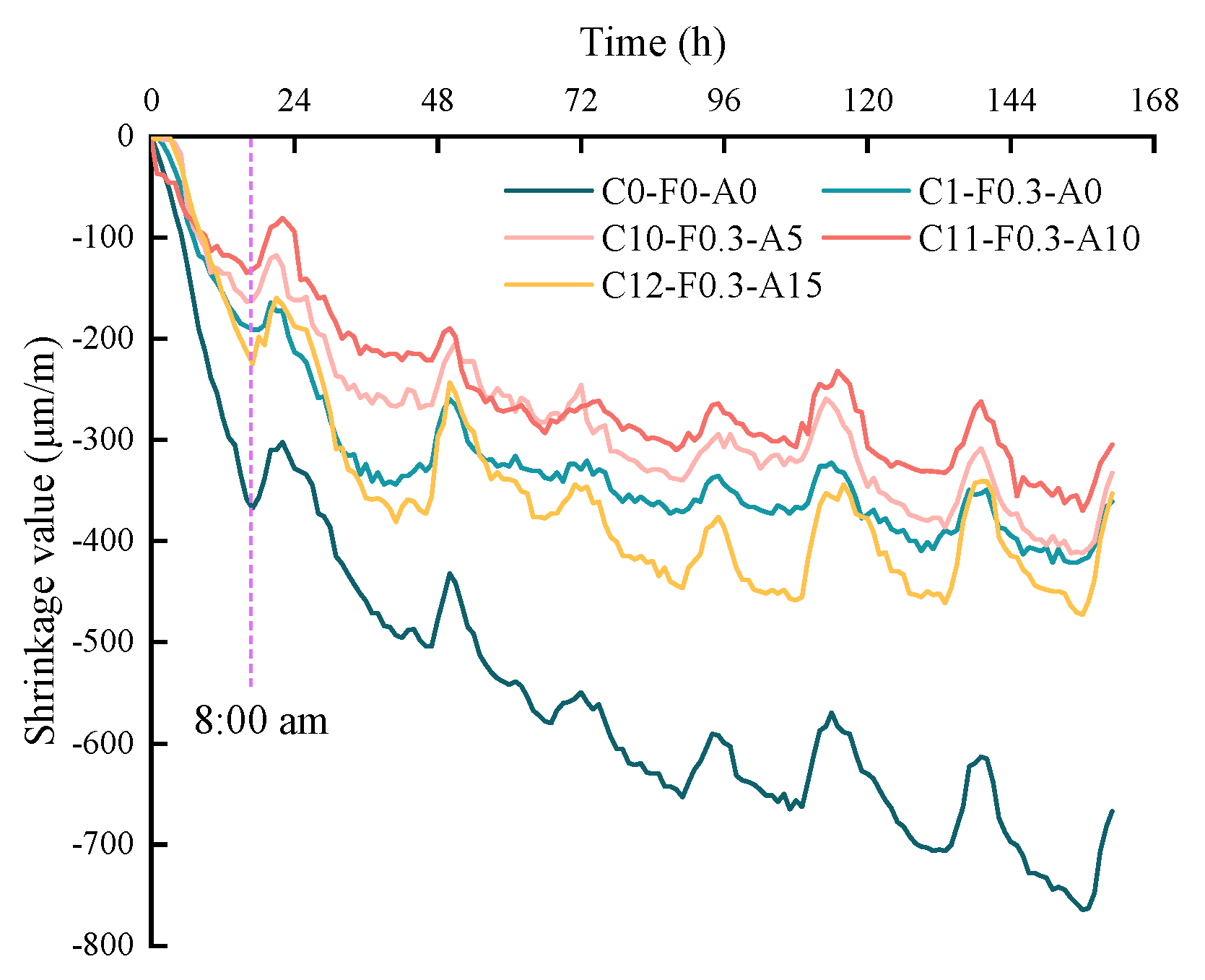


| Materials | Chemical Composition (wt%) | ||||||||
|---|---|---|---|---|---|---|---|---|---|
| SiO2 | Al2O3 | CaO | Fe2O3 | MgO | SO3 | Na2O | Loss | Cl− | |
| OPC | 22.81 | 4.52 | 62.64 | 3.46 | 2.05 | 2.75 | 0.53 | 1.23 | 0.02 |
| Initial Setting Time (min) | Final Setting Time (min) | Density (g/cm3) | Specific Surface Area (m2/kg) | Consistency/ % | Stability (Ray Method)/mm |
|---|---|---|---|---|---|
| 161 | 214 | 3.14 | 340 | 25.2 | 0.1 |
| Specific Density (g/cm3) | Apparent Density (g/cm3) | Fineness Module | d50 (mm) | Cu | Cc |
|---|---|---|---|---|---|
| 2.63 | 1.46 | 2.48 | 1.617 | 1.57 | 0.96 |
| Type | Cement (kg/m3) | Sand (kg/m3) | Water (kg/m3) | YDF/% | YDA/% | SP/% | w/c |
|---|---|---|---|---|---|---|---|
| C0-F0-A0 | 600 | 1200 | 240 | — | — | 1.5 | 0.4 |
| C1-F0.3-A0 | 600 | 1200 | 240 | 0.3 | — | 1.5 | 0.4 |
| C2-F0.5-A0 | 600 | 1200 | 240 | 0.5 | — | 1.5 | 0.4 |
| C3-F0.7-A0 | 600 | 1200 | 240 | 0.7 | — | 1.5 | 0.4 |
| C4-UF0.3-A0 | 600 | 1200 | 240 | 0.3 | — | 1.5 | 0.4 |
| C5-UF0.5-A0 | 600 | 1200 | 240 | 0.5 | — | 1.5 | 0.4 |
| C6-UF0.7-A0 | 600 | 1200 | 240 | 0.7 | — | 1.5 | 0.4 |
| C7-F0-A5 | 570 | 1200 | 240 | — | 5 | 1.5 | 0.4 |
| C8-F0-A10 | 540 | 1200 | 240 | — | 10 | 1.5 | 0.4 |
| C9-F0-A15 | 510 | 1200 | 240 | — | 15 | 1.5 | 0.4 |
| C10-F0.3-A5 | 570 | 1200 | 240 | 0.3 | 5 | 1.5 | 0.4 |
| C11-F0.3-A10 | 540 | 1200 | 240 | 0.3 | 10 | 1.5 | 0.4 |
| C12-F0.3-A15 | 510 | 1200 | 240 | 0.3 | 15 | 1.5 | 0.4 |
| Source | Sum of Squares | DF | Mean Square | F-Value | p-Value | |
|---|---|---|---|---|---|---|
| Fluidity | YDF type | 10.880 | 1 | 10.880 | 1.272 | 0.311 |
| YDF content | 603.893 | 3 | 201.298 | 23.530 | 0.002 | |
| YDA content | 2124.921 | 3 | 708.307 | 82.797 | <0.001 | |
| 28 d Compressive Strength | YDF type | 26.403 | 1 | 26.403 | 7.327 | 0.042 |
| YDF content | 337.533 | 3 | 112.511 | 31.221 | 0.001 | |
| YDA content | 31.849 | 3 | 10.616 | 2.946 | 0.138 | |
| 28 d Flexural Strength | YDF type | 0.019 | 1 | 0.019 | 0.084 | 0.783 |
| YDF content | 2.438 | 3 | 0.813 | 3.690 | 0.097 | |
| YDA content | 2.261 | 3 | 0.754 | 3.423 | 0.109 | |
| 156 h shrinkage strain | YDF content | 99,371.868 | 1 | 99,371.868 | 58.494 | 0.005 |
| YDA content | 44,197.950 | 3 | 14,732.650 | 0.224 | 0.864 |
Disclaimer/Publisher’s Note: The statements, opinions and data contained in all publications are solely those of the individual author(s) and contributor(s) and not of MDPI and/or the editor(s). MDPI and/or the editor(s) disclaim responsibility for any injury to people or property resulting from any ideas, methods, instructions or products referred to in the content. |
© 2023 by the authors. Licensee MDPI, Basel, Switzerland. This article is an open access article distributed under the terms and conditions of the Creative Commons Attribution (CC BY) license (https://creativecommons.org/licenses/by/4.0/).
Share and Cite
Zhu, X.; Li, L.; Tian, B.; Zhang, P.; Wang, J. Synergistic Effect of Yak Dung Fiber and Yak Dung Ash on the Mechanical and Shrinkage Properties of Cement Mortar. Materials 2023, 16, 719. https://doi.org/10.3390/ma16020719
Zhu X, Li L, Tian B, Zhang P, Wang J. Synergistic Effect of Yak Dung Fiber and Yak Dung Ash on the Mechanical and Shrinkage Properties of Cement Mortar. Materials. 2023; 16(2):719. https://doi.org/10.3390/ma16020719
Chicago/Turabian StyleZhu, Xuwei, Lihui Li, Bo Tian, Panpan Zhang, and Junjie Wang. 2023. "Synergistic Effect of Yak Dung Fiber and Yak Dung Ash on the Mechanical and Shrinkage Properties of Cement Mortar" Materials 16, no. 2: 719. https://doi.org/10.3390/ma16020719
APA StyleZhu, X., Li, L., Tian, B., Zhang, P., & Wang, J. (2023). Synergistic Effect of Yak Dung Fiber and Yak Dung Ash on the Mechanical and Shrinkage Properties of Cement Mortar. Materials, 16(2), 719. https://doi.org/10.3390/ma16020719






